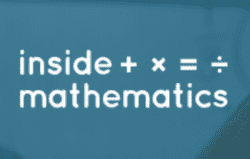This lesson is a re-engagement lesson designed for learners to revisit a problem-solving task they have already experienced.
My colleague Stacy Emory best describes re-engagement by comparing it to re-teaching. Re-teaching is a teacher-directed activity where we plan a different lesson to address something that is perceived to be a misconception with our students. Re-engagement is a learner-centered activity wherein the original task is posed in such a way that we may expose learners to different strategies, alternate solutions, or even misconceptions. Think of the original task as a formative assessment that helps you shape the lessons that follow.
As learners enter the 6th grade, they have had many experiences with modeling and describing numeric patterns. The “Buttons” task comes from the 2003 MARS test for grade 5. Within this task learners are asked to investigate a numeric pattern and to generalize what they see happening as the pattern grows. Counting on strategies will work, but there is a clear emphasis and interest on our part as educators on moving learners towards multiplicative thinking in this task. This increase in cognitive demand needs to be further explored to ensure the learners are making connections between the numeric pattern and a generalized “rule” or function. There are five representations that learners should be exploring as they puzzle with numeric patterns/algebraic thinking: pictorial, numerical, verbal, graphical, and algebraic representations.
**Main Goals of the Lesson**
– Activate prior knowledge of graphical representations through the “what’s my rule” number talk
– Compare and contrast two different learners’ interpretations of the growing pattern
– Use multiple representations to demonstrate how one of these learners would represent the numeric pattern
– Make connections between the different representations to more critically compare the two interpretations
**Standards Addressed**
– Algebra and Functions 1.0
– Mathematical Reasoning 1.0
– This lesson also touches on all of the NCTM Process Standards: Problem Solving, Reasoning and Proof, Communication, Connections, and Representations
**Challenges for Students with this Content**
– Experience with using one or more of the representations will vary from learner to learner
– Some learners find it very difficult to try and understand someone else’s thinking, especially if it is divergent from their own
– Visualizing the pattern beyond what is shown may be tough – having a manipulative such as buttons or tiles on hand would be useful
– In the pictorial representation, having learners color code their model could be a sticking point if the learners have not had prior experience with this strategy. Even with prior experience, this turned out to be a sticky point for many learners in my class
Taught By




